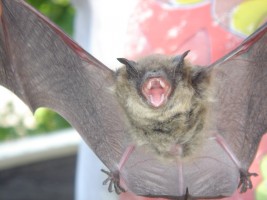
Bats aren’t seen as one of the most cute or lovable animals in the world. In fact, many people are fearful of them. They get a bad reputation for being creatures that lurk at night. The reference that they are vampires has been deeply seeded into various cultures and that further instills fear.
Others, understand the value and importance bats play in the environment. Bats are often considered “keystone species” that are essential to some tropical and desert ecosystems. Without bats’ pollination and seed-dispersing services, local ecosystems could gradually collapse as plants fail to provide food and cover for wildlife species near the base of the food chain.
Consider the great baobab tree of the East African Savannah. It is so critical to the survival of so many wild species that it is often called the “African Tree of Life.” Yet it depends almost exclusively on bats for pollination. Without bats, the Tree of Life could die out, threatening one of our planet’s richest ecosystems.
Below, we provide some more information about what makes these animals so truly amazing and unique.
1: A small colony of bats can eat over one ton of insects in one year, or more than 600 million bugs, A single bat can eat more than 600 bugs in one hour, which is like a person eating 20 pizzas a night.
2: According to Bat Conservation International, 150 big brown bats can eat enough cucumber beetles in one summer to save farmers a billion dollars a year. Those beetles would have created 33 million larvae, which are what attack the crops
3: There are over 1,100 bat species in the world—only rodents have a greater number of species.
4: Some seeds will not sprout unless they have passed through the digestive tracts of a bat. Additionally, bats spread millions of seeds every year from the ripe fruit they eat. Approximately 95% of the reforestation of the tropical rain forest is a result of seed dispersal from bats
5: Bats live on every continent except Antarctica. They are found almost as far north as the Arctic Circle and as far south as Argentina and the southern-most tip of South Africa.
6: Bats are not blind and, in fact, many bats can see quite well; some species can even detect ultraviolet light. They also have excellent echolocation, which means, contrary to urban legend, they would not get tangled in people’s hair.
7: Bats can hear frequencies between 20 Hz and 120,000 Hz. Humans can hear between 20 Hz and 20,000 Hz. Dogs can hear between 40 Hz and 60,000 Hz.
8: Bat droppings, called guano, are one of the richest fertilizers. Bat guano was once a big business. Guano was Texas’s largest mineral export before oil! During the U.S. civil war, bat droppings were used to make gunpowder.
9: Bat wings are made from finger bones covered by thin layers of skin. The wing membranes of a bat make up about 95% of its body surface area. A bat’s wing membrane helps the bat regulate body temperature, blood pressure, water balance, and gas exchange.
10: A bat uses 30-60 days of stored energy to wake up out of hibernation. That is why it is so important to not disturb hibernating bats.
11: Bats make up a quarter of all mammals found on earth.
12: Scientists in several countries are trying to copy the enzymes found in vampire bat saliva to treat heart conditions and stop the effects of strokes in humans.
13: Bats have an extraordinary long lifespan for their size- they are known to live to around 20 years, and at least one brown bat was documented to have lived 30 years.
14: Bats can find their food in total darkness. They locate insects by emitting inaudible high-pitched sounds, 10-20 beeps per second and listening to echoes.
15: More than half of the bat species in the United States are in severe decline or listed as endangered. In addition to loss of habitat, one of the direst threats comes from white nose syndrome, a disease that has decimated bats in the U.S. and Canada. The Nature Conservancy collaborated in a recent breakthrough, successfully treating and releasing infected bats.
16: Most bats have only one pup a year, making them extremely vulnerable to extinction. Bat mothers can find their babies among thousands or millions of other bats by their unique voices and scents.
17: The world’s largest bat is the “flying fox” that lives on islands in the South Pacific. It has a wingspan of up to 6 feet. The world’s smallest bat is the bumblebee bat of Thailand, which is smaller than a thumbnail and weighs less than a penny.
18: More than 300 species of plants depend on bats to survive in many tropical and desert ecosystems. These include plants that humans eat, like the agave used to make tequila, as well as banana, peach, and mango trees.
19: To survive the winter some species of bat migrate, others hibernate, and yet others go into torpor (regulated hypothermia that can last from a few hours to a few months)
20: The bat has a very long tongue that it uses for feeding and pollination. When not in use the tongue is wound up around the rib cage.
Understanding more about bats can help people learn to not be afraid of these valuable animals, and hopefully appreciate all the positive things they do for our planet.



